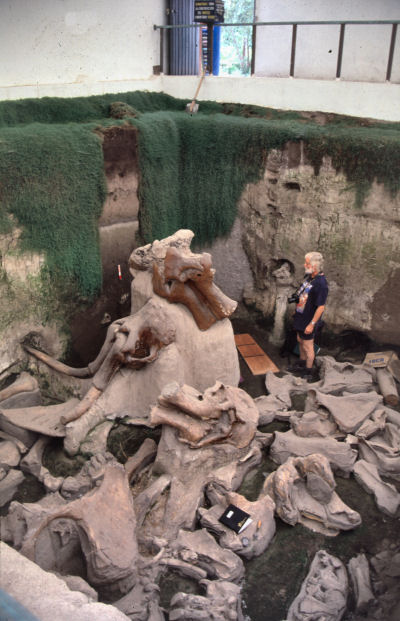
© LJMUProfessor Dave Huddart, Director of Research and Enterprise at LJMU.
Research that shows how a volcanic event might have wiped out mammoths, including sabre-toothed cats, in the Basin of Mexico has been reported by LJMU Professors Dave Huddart and Silvia Gonzalez. They worked in collaboration with the Universidad Michoacana de San Nicolas de Hidalgo and the United States Geological Survey to report these findings in the
Quaternary Science Reviews (2014).
They discovered that the extinction could have been caused by a series of volcanic events and therefore the primary cause was environmental disruption and not man-made factors. This is despite the fact that Paleo-Indian populations were also present in this region at this time and several have been found associated with the volcanic ash deposits.
Most of the work was carried out at Tocuila Mammoth Museum (Texcoco) where over a 1,000 bones from at least seven Columbian mammoths were found and are exposed in volcanic mudflow deposits from an eruption of Nevado de Toluca volcano. These are interbedded in a series of lake sediments with many volcanic ashes and the meteorite airburst layer. The sequence has been dated by radiocarbon dating of bones and shells and from the various volcanic ash layers which act as marker horizons.
Professor Dave Huddart, Director of Research and Enterprise at LJMU explains:
"The eruption must have caused widespread environmental disruption in the region with evidence of extensive reworking and channelling by the Lake Texcoco shoreline and contributed to the widespread death and/or extinction of megafaunal populations, as suggested by earlier authors, but the new work reinforces the view that both catastrophic events must have caused large environmental disruption in a short time period."
LJMU Professor in Quaternary Geology and Geoarchaeology Silvia Gonzalez adds:
"At that site there is evidence for a meteorite airburst layer dated between 10,878 and 10,707 cal BC at the onset of the Younger Dryas cool period. Shortly after, the Upper Toluca Pumice volcanic ash marker was produced, caused by a major volcanic eruption of the Nevado de Toluca volcano dated from 10,666 to 10,612 cal BC . Both natural events must have caused widespread environmental disruption in the Basin of Mexico and the widespread death and/or extinction of megafaunal populations within a period of approximately two hundred years.
"There is no evidence for megafauna such as mammoths, sabre-toothed cats, camels, or bison after the volcanic event."
The paper is available at the
Quaternary Science Reviews (2014)

Reader Comments
to our Newsletter